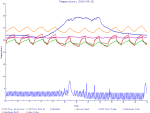Doesn't anyone know what a thermostat is?
First published: 25th October 2010
This rant is prompted by a letter in the South China Morning Post (3rd Sept, 2010, "Lukewarm on air-con scheme"), where the writer criticised the proposal by Green Sense for people to switch off air conditioners for 12 hours on September 29. The writer thought that 12 hours was too long for anyone to go without air-con, but only doing this on one day would not have a significant effect on the environment, and therefore proposed turning off air-cons for a couple of hours, then on, creating a balance between a comfortable indoor environment, and the use of energy.
Firstly, I think the writer was missing the point, Green Sense was proposing a one-off event to raise awareness of the problem, and to demonstrate to people that they can survive without air-con. It seems they were not successful in changing people's habits, but this strategy can and has been successful in other circumstances.
However, my major bone of contention with the writer is his proposal for manually switching air-cons on and off. All air-cons have an automatic control system that switches the compressor motor on and off according to feedback about the room temperature provided by a sensor. This is called a thermostat (therm: relating to temperature; stat: constant; a device to keep the temperature constant).
On many, particularly older, air-cons, the temperature control is fairly crude: the sensor switches on the compressor when the temperature is above a certain temperature, and switches it off when the temperature falls below another, slightly lower, temperature (see hysteresis). The temperature in the room wavers around the desired temperature. A typical result can be seen in fig. 1, temperature readings from around my workplace on 19th Sept., four of the lines show an on-off pattern, rising and falling ten times during the day. In a fifth line, "Warehouse South", the pattern can still be identified, but it is much less pronounced. The remaining two lines are a fridge, which shows it's own, much faster, on-off pattern, and "WindowA", which is outside the air-conditioned area, and gives an indication of the outside temperature.
So, ten on-off cycles a day, that is an average of 144 minutes per cycle, very similar to the writer's couple of hours. A simple, crudely controlled air-con is doing what the letter-writer wants automatically. Furthermore, is will make a much better job of it than a human, because it won't forget, or fall asleep, or feel hotter or colder because of it's emotional state.
Some newer air-cons have a more sophisticated control system, not just turning the compressor on and off, but varying the power so that the room temperature stays closer to the desired point in the most efficient manner. Crudely turning the machine on and off due to a misplaced desire to "save energy" is micro-management at its most destructive.
So, the first step to reducing our air-con energy use is to understand what we are trying to achieve when we use air-con. In our homes and offices, it is to have a comfortable environment, but in our warehouses and fridges (a fridge is just an air-con in a box... or maybe an air-con is a fridge in a room), our objective is to prevent spoilage. There is no point in saying, "We're going to save energy by raising all thermostat set points by 5°", and then finding your milk has gone sour, and 40 tonnes of goods are unfit for consumption. Also, for an office setting, the objective is productivity. People don't work well when sweaty and drowsy from heat and humidity, but they also don't work well with numb fingers, shivering in the cold.
The next step is understanding the sources of heat and its flow. The major source of heat is the sun, both direct sunshine and indirectly with hot, humid air. People, computers and other equipment produce heat. Walls, floors and ceilings can store heat. Airflow changes people's perception of heat - warm air blowing across a person's skin will cool them by evaporating sweat (make sure you provide drinks), but it will not cool a computer. Different parts of the same indoor area can have quite different temperatures, as can be seen from fig. 1.
With better understanding of the environment, we can plan the whole system to give the desired result, and build a control system to make it happen automatically. Blindly usurping the control system with a dumb rule is going to make things worse.

